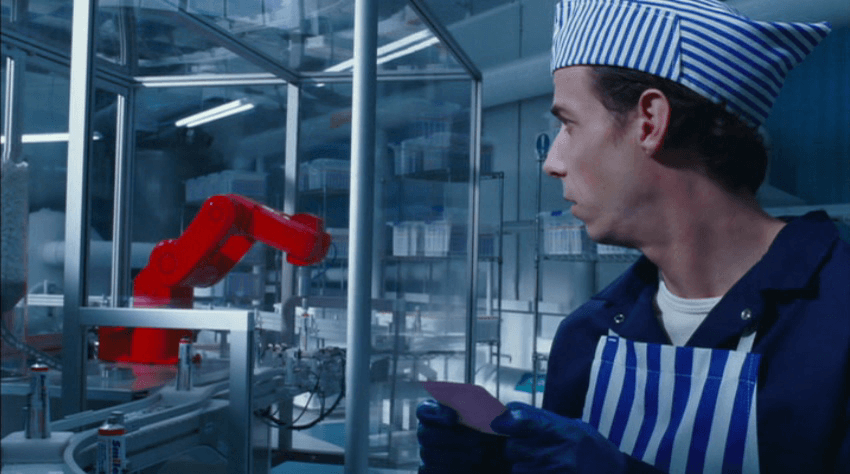AI and the Marching Morons

In 1951, the science fiction writer Cyril M. Kornbluth published a story called “The Marching Morons” in Galaxy Magazine. (You can read the whole thing here.) It tells the story of a near future world in which stupid people with limited skills overpopulate the world, forcing a dwindling group of intelligent people to take on the increasingly difficult task of managing the world. This Wikipedia summary is about right.
In 1988, real estate agent and con artist John Barlow is placed in suspended animation after a freak accident. He is revived in the distant future, in a confusing world filled with hypersexualized advertisements, vapid entertainment, and people who exhibit erratic, nonsensical behavior. Shortly after being revived, Barlow is introduced to two men who tell him that the current state of society is the fault of the “morons,” the world’s vast population of unintelligent people, who greatly outnumber the much smaller population of intelligent people.
These men explain to Barlow that the most urgent crisis of their time is the population problem (“Poprob”). Historically, people of higher intelligence often chose to have few children (or no children at all) for pragmatic reasons, while people of lower intelligence, compelled by their sex drives, had larger families and reproduced in greater numbers. By the far future era in which Barlow has awakened, this unbalanced trend has been carried to its logical extreme, with a total world population of five billion morons (with an average IQ of 45) living under the supervision of three million members of an elite, intellectual upper-class who secretly govern world affairs.
The simple-minded morons cannot be left to govern themselves or else the world will descend into chaos and war. As a result, the elite minority are effectively “enslaved” by the moron majority, working themselves to exhaustion while trying to maintain global order and stability. Controlling the morons’ population growth is impractical for several reasons, but unless some corrective action is taken, the inevitable outcome will be the collapse of human civilization. All attempts to solve Poprob have failed, and the elite hope that Barlow, as a man from a different time and with a different perspective on the problem, might be able to offer a novel solution.
What does this have to do with AI?
Obviously, this didn’t happen in 1988. But artificial intelligence is now on the verge of causing an epochal shift in the way people do work. Goldman Sachs predicts that generative AI tools like ChatGPT would affect more than 300 million jobs, and that “use of AI technology could also boost labor productivity growth and boost global GDP by as much as 7% over time.”
What does it mean to “boost labor productivity growth?” It means that fewer people can do more work. Instead of an army of coders, imagine one-third as many, using AI tools to be more productive. The same calculus applies to any other jobs involved in what is still quaintly described as “knowledge work.” Graphic designers. Copywriters. Business analysts. Customer service representatives. Reporters. Novelists. Pharmaceutical researchers. The list is endless.
If you create or synthesize information to create content or serve customers, things will change — massively. I’m not saying that your job will go away. I’m saying that the smartest 20% among you and your colleagues will do all of your work with the aid of AI.

Historically, these types of automation shifts have required retraining people who did the work that machines took over — typically in jobs of designing, building, maintaining the machines. (Remember Charlie Bucket’s dad in Willie Wonka who switched from putting the caps on toothpaste tubes to maintaining the machine that puts the caps on the tubes?) But I fear that the number of new jobs created by AI will be far fewer than the jobs that are lost. I don’t think all copywriters are suited to become AI copywriting managers, nor are most customer service reps ready to be chatbot engineers.
Unlike “The Marching Morons,” the workers who lose their jobs will be skilled and trained. They just won’t be skilled and trained in a way suited to the AI supervision jobs of the future, and most of them will never get there.
What will become of millions of formerly well-paid knowledge workers for which society has not much use? There are only so many suited to become massage therapists and nurses and other hard-to-automate jobs. They’ll be idle and angry.
Idle, angry, and formerly productive people will become a political force. They’ll be susceptible to ideologies that promise to restore things that they once had. (Make America Great Again, anyone?)
Barlow’s solution to the Poprob in “The Marching Morons” was to con the population into “emigrating to Venus” (although they were actually shot into space to die). Today we entertain them with cars that can accelerate quickly, huge spaceships that actually blow up, and social media that numbs the brain. (Is it a coincidence that Elon Musk is in charge of all of those — and wants to start his own AI system? Maybe he really is a genius.)
Where is this going? I don’t know. But I do know this: the media, political, and entertainment folks who can engage the imaginations of the newly idle class of knowledge workers will be the leaders of tomorrow. Whether those leaders are a force for good or evil may determine the future of our civilization.
Well, this one hit a little too close to home. The parallels with current society and politics make me want to fund some people’s trip to Venus.
Did you ever see the movie “Iodiocracy”? it is probably based on that short story – after 500 years, a guy who was not very bright to begin with, wakes up to find the world is filled with idiots, and he is the smartest guy around.
Idiocracy is not officially based on that story, but others have noted the resemblance in some plot points.
FYI, Elon was a cofounder of OpenAI which created ChatGPT.